Obituary:
Mary Welsh
A tribute to Mary Welsh, Big Issue North's walks expert for nine years, by her daughter Cheryl Campbell – plus her last four walks for us
Mary Welsh, whose 50 books and countless published walks led thousands of walkers over mountains and through the countryside for 35 years, has died at the age of 88.
Mary wrote her first book in 1982, at the age of 53. She had moved from Islington in central London to the Lake District. A Country Journal – The Diary of a Cumbrian Naturalist charted her delight in the nature she saw as she explored the village of Broughton-in-Furness, where she had moved to, and wider Cumbria.
Her latest walk appeared in the December 2016 edition of Country Walking.
Starting with the publication of A Country Journal, and finishing with her last book Walking Fife, The Ochils, Tayside and Forth Valley in 2012, Mary authored 38 books and 12 substantial booklets. Many went into third, fourth and some even fifth reprints, selling more than 200,000 copies.
Mary was meticulous about checking and noting every stile and waymark, determined to ensure that her readers didn’t get lost. Her joy was in sharing the sights and sounds of the countryside she discovered. She had extensive knowledge of flora and fauna, and a passion for ornithology, identifying and delighting in birdsongs wherever she went.
From 1985 to 1989 the Westmorland Gazette published her four-book series A Naturalist’s Guide to Lakeland Waterfalls Throughout the Year. She became an established columnist for the Kendal-based paper and wrote 692 columns for it over many years, taking and providing the accompanying photos as well.
She was Big Issue North’s walking expert from 2007 to 2016, producing quarterly series of walks covering the North West and Yorkshire and Humber that were very popular among readers.
Her magnum opus was 21 books covering the whole of Scotland in a series called Walking Scotland. Published by Clan Books each volume contains 40 walks. She produced them with her friend Christine Isherwood and together they covered nearly 6,000 miles to complete the series – a “wonderful, magical task”, according to Mary.
Mary grew up in Hemel Hempstead, the third child of Walter and Ethel Croker, who had moved from the West Country before the First World War. She spent her childhood exploring the local countryside and, once into her teens, started youth hostelling, eventually exploring and falling in love with Scotland.
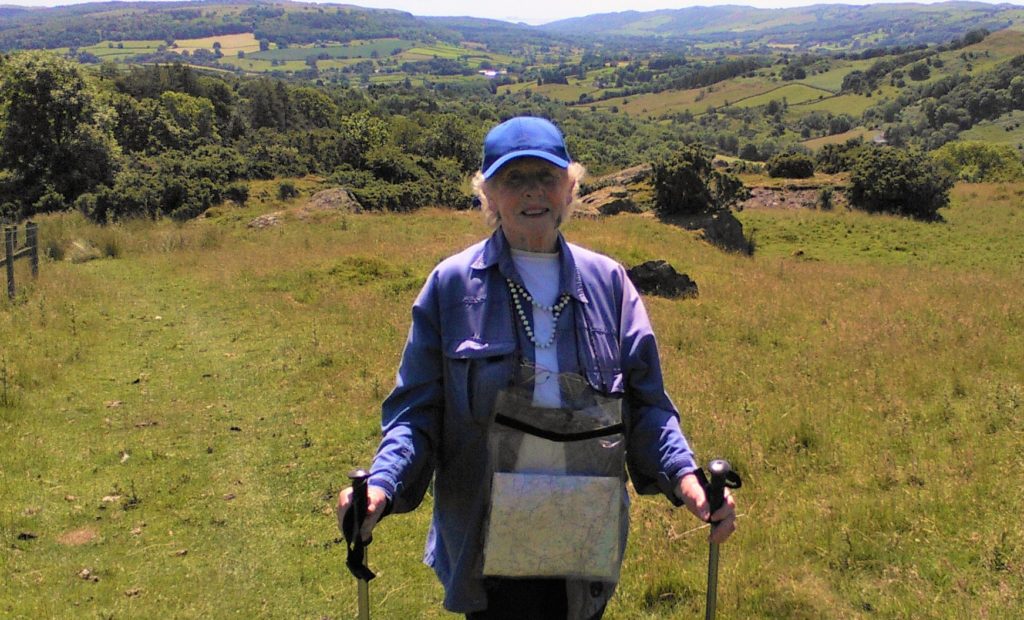
It was on a youth hostelling trip to Devon in 1947 that she met her future husband, Tom Welsh, who became a journalist and editor of Essential Law for Journalists.
Mary trained as a teacher at Furzedown Training College in Streatham snd taught for three decades around London. Her passion and her subject was biology, and in the early 1970s she returned to study part time to secure a degree in ecology and animal behaviour.
In 1979, Tom was appointed editor of the North West Evening Mail in Barrow-in-Furness and Mary took up a teaching post at Whitehaven Grammar School, moving later to John Ruskin School in Coniston. They uprooted from their home in Islington to move to Broughton-in-Furness.
Mary absolutely loved it – her joy in village life in the middle of breathtaking countryside sings out from every page of A Country Journal. They never wanted to leave but, after Tom’s death in 2014, Mary moved south in March 2016 to be closer to her four children in London.
She continued to walk after the move, delighting in the forests of Essex, the hills of the Chilterns and the hidden gems of London, and had already started preparing a portfolio of walks in the south. Mary died of a heart attack on 11 January. She is sadly missed by her two daughters, her two sons, their partners, and six grandsons, all of whom often accompanied her on her walks.
Jericho was the name of one of the shanty towns where lived some of the 6,000 men employed in building the magnificent viaduct. It was also the name given to the popular television series. It cost £3.5 million to construct, an enormous amount in Victorian times. It was opened in 1876.
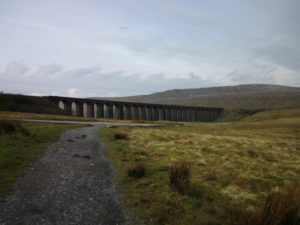 1 Cross the road from the parking area to take the well reinforced signed track towards the viaduct. This soon joins another track on which you continue until it turns left and passes under the viaduct. You need to go on walking ahead along the side of the railway line above you on your left. Ignore a left turn under the line and go on to pass a tall railway signal. Just beyond, turn left under the signed railway arch and through the gate beyond.
1 Cross the road from the parking area to take the well reinforced signed track towards the viaduct. This soon joins another track on which you continue until it turns left and passes under the viaduct. You need to go on walking ahead along the side of the railway line above you on your left. Ignore a left turn under the line and go on to pass a tall railway signal. Just beyond, turn left under the signed railway arch and through the gate beyond.
2 Follow the track down Turf Hill, cross a stream, then wind left to pass through buildings at Winterscales Farm and over a pleasing bridge. Carry on along the lane over two cattle grids, pass a barn and go through a metal gate, followed by a wooden gate. Stroll on over the lovely limestone fields, crossing a “bridge” of railway sleepers. Beyond approach the wall ahead and here take a small easy-to-miss gate. Carry on over several gated fields to reach Boardrake Farm, where a walkers’ barn is being constructed.
3 Turn sharp left on a good track. Look left as you go over the intervening moorland to see the viaduct. Every sixth pillar is thicker than those on either side. It was built so that if a pillar collapsed only the five beside it would collapse rather than the whole viaduct. Where the track winds right towards another farm, keep ahead, then turn sharp left on the far side of a fence, walking a grassy track and heading to an obvious ladderstile, or use the gate.
4 Keep on the track as it winds through fields to reach the bed of Winterscales Beck, usually dry all summer. Go over this and follow the track to reach a narrow lane close to a cattle grid. Turn left. Walk on to cross a bridge, beyond which the track soon divides. Take the right branch and head towards the viaduct. Go right at next gate to cross a bridge and then on through farm buildings. Head on through two more gates and step out on the track to pass under the viaduct and carry onto the road and where you have parked.
Information
Distance: 8km (5 miles) Time: 2-3 hours Height gain: Very little – 100m/328ft Terrain: Mainly good paths and track. A little lane walking. One muddy path Public transport: Traveline 0300 123 4050 Park: Near the viaduct – at junction of the B6479 and B6255 Public toilets: None on route Refreshments and facilities: Spoilt for choice in Ingleton Map: OS Explorer OL2/Landranger
This is a well-known and loved walk that takes you through the lovely heart of the Lake District. An enormous amount of work has been done on some of the tracks, which are part of the Cumbria Way. It is great that the disabled can enjoy parts of the way.
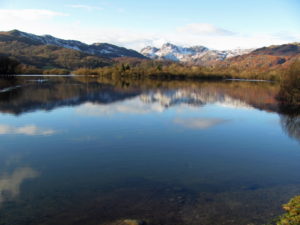 1 Walk through Elterwater village. Turn into pay-and-display car park by bridge over River Brathay. Continue on track with beck, right. Soon track moves into woodland, then close to Elterwater Tarn where a seat reveals fabulous views of the Langdale Pikes. Carry on beside surging river, then into wooded area where the path divides – go ahead to visit the magnificent Skelwith Force or right to cross Chris Bammall’s amazing iron bridge that strides the river. Beyond, climb through trees to cross of tracks. Go ahead towards Colwith Bridge.
1 Walk through Elterwater village. Turn into pay-and-display car park by bridge over River Brathay. Continue on track with beck, right. Soon track moves into woodland, then close to Elterwater Tarn where a seat reveals fabulous views of the Langdale Pikes. Carry on beside surging river, then into wooded area where the path divides – go ahead to visit the magnificent Skelwith Force or right to cross Chris Bammall’s amazing iron bridge that strides the river. Beyond, climb through trees to cross of tracks. Go ahead towards Colwith Bridge.
2 Follow track to gate and out into open pasture, with more fine views. Ignore track on left and dawdle on past two cottages. Squeeze through narrow gate. Descend a little before ascending to Park Farm. Pass between buildings and notice apprentice slab, covered with well-crafted letters. Ignore left turn. Go ahead to take stile over wall. Beyond, carry on through passage between hedge and fence to cross access track to take gate opposite. Walk on to stile into woodland to begin descent of un-railed stepped way to riverside. Follow path across pasture to stepped and gated stile straight onto narrow road.
3 Turn right for a few steps. Climb railed steps to gate into woodland clearing. A signpost directs right to Colwith Force or uphill to High Park. Both paths come together, high up beside wall, where track leads on to buildings and lane at High Park. Bear right, descend to valley, passing Stang End, where road drops left. At valley, bear right to side of ford and bridge across the Brathay – but do not cross. Walk left, with river right, for 200yds to locked gate set back left. Here, climb stile then short track to entrance, right, into magnificent Cathedral Cave – not to be missed.
4 Return to track. Walk on to take, almost immediately, gate, right, to path across meadow to step stile onto famous Slater Bridge. Nineteenth century quarrymen built and used it to get to work. Cross the lovely structure, ascend reinforced path, left of wall. Look left to see tarn, in its beautiful setting. At top of slope, go through gate and along access track to join road. Take narrow lane almost opposite. Climb gently past Dale End Farm and on to gate into woodland. Descend roughly reinforced track, down to Elterwater village.
Information
Distance: 6 miles/9.5km Time: 3-4 hours Height gain: 600ft/190m Terrain: Good paths, tracks, and narrow lanes, except for rough track towards end of walk. Public transport: Traveline 0300 123 4050 Park: Free parking area, grid ref 329051. Pay and display in centre of village. Or if all are full, park in reinforced spaces on roadside, north of the village Public toilets: Centre of village, opposite pub Refreshments and facilities: Elterwater village well supplied Map: OS Explorer OL7 English Lakes, south-eastern area/Landranger 90
One of the legends about how Devil’s Bridge got its name claims that an old woman, whose cow and pony strayed into the river, made a promise to the Devil that if he raised a bridge so that her stock could cross, he could have the first thing to do so. Early next morning the old woman threw a bun over the bridge and her mangy dog ran after it. The devil, expecting he would gain a pony or a cow, vanished angrily in flames.
1 From the parking area, cross the road and go through the entrance opposite just before Devil’s Bridge and descend steps to a path beside the river. Pause to look at the magnificent 15th century twin-arched bridge and its lovely surrounds. Go on towards the next bridge and wind up a little right to cross the A65, with care. Descend more steps to continue on the Lune Valley ramble.
2 Walk on downstream to pass the next bridge, which carries great pipes over the Lune for the water company. Then take the small bypass of the river bank over two step stiles to rejoin the riverside. Carry on beside the river to reach an area where the New Year floods have worn the banking. This bit of the path demands more energy and care. Stroll on, sometimes high above the river and sometimes close beside it, until you can see the houses of Nether Burrow. Here take a hedged way, Burrow Mill Lane, that leads you to the large village of Whittington.
3 Cross the B6254 and after a few steps left, take the entrance on the right to walk the long track leading to the Church of St Michael the Archangel, high on its little hill, where a seat in the churchyard provides delightful views for your first break. Stroll round the church to join the road and descend to a junction. Turn left to walk the busy B-road, facing the oncoming traffic, for ¼ mile and, at a wide bend left, take a hedged track descending right to cross a footbridge over a small stream.
4 Beyond, the right of way continues along the right boundary to a stile to the river bank. If it is too difficult to climb because of an awkward overgrown thorn bush walk left along the boundary to come to a track on your right and go through a metal gate, right. Beyond, turn left and use your outward route to return to Kirkby Lonsdale.
Information
Distance: 5½ miles Time: 2-3 hours Height gain: Virtually none Terrain: Generally good walking on grassy paths and a track. Some road walking Public transport: Traveline 0300 123 4050 Park: Free parking just before (west) of Devil’s Bridge, grid ref 616784 Public toilets: Just before Devil’s Bridge beside parked cars Refreshments and facilities: Spoilt for choice in Kirkby Lonsdale Map: OS Explorer OL2
From the little cairn on Bleaberry Fell (590m) enjoy the stunning views and the sweet smelling heather. Once walkers on the way to the little summit had to plough a path through seriously extensive bog. Now, following £10,000 from an anonymous donor, Fix The Fells and others have used an ancient method of repair and the route is a delight.
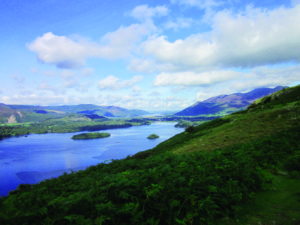 1 From the small parking area just above Ashness Bridge, turn left to cross it. A few steps on, take, on the right, a narrow path leading away from the road. Follow this steadily uphill to pass through a gate. Ahead are three paths. Here you need to turn acute right to take an easy-to-miss path up through the bracken (alas, lots here) and climb steadily to a gate onto a wide track. Bear left and carry on ascending the grassy, stony way from where there are magnificent views of Derwent Water and Bassenthwaite Lake. Across the lake, look for Catbells, Causey Pike and more.
1 From the small parking area just above Ashness Bridge, turn left to cross it. A few steps on, take, on the right, a narrow path leading away from the road. Follow this steadily uphill to pass through a gate. Ahead are three paths. Here you need to turn acute right to take an easy-to-miss path up through the bracken (alas, lots here) and climb steadily to a gate onto a wide track. Bear left and carry on ascending the grassy, stony way from where there are magnificent views of Derwent Water and Bassenthwaite Lake. Across the lake, look for Catbells, Causey Pike and more.
2 Continue on the path as it winds away from the lake below Falcon Crag. From here you have a dramatic view into Cat Gill and Lady’s Rake. Legend, or perhaps truth, tells us that the lady was the young Countess of Derwentwater fleeing up the Rake from her island home with the family’s jewels, after her husband was captured for his part in the Jacobite rebellion of 1715. The continuing path drops a little and then rises and as it starts to cross the open fell towards woodland. Be alert here for, right, the new path. Look up and back towards Bleaberry Fell, behind you at this point, and you will see the pleasing path zigzagging up the slopes, with High Seat towering above it to its south.
3 After a short stretch of grass you step onto the path and take every step with pleasure. Acres of heather stretch away across the lovely slope to your left, with further magic views beyond. The path ends suddenly and a grassy way continues, with Bleaberry Fell directly ahead. The path/track is stony and grassy in parts. Follow it as it winds to the left of the rounded, pudding-like fell and then you reach an old gathering pen for sheep. Just before it a narrow grassy path, right, climbs easily and then bears right and leads directly to the little cairn. The view is spectacular.
4 Some walkers will want to go on to climb High Seat but this walk returns by descending to the old pen and then following the path, left, downhill. Just before you join the new path, you might wish to take a narrow grassy path, left. It is marked by a large stone with two smaller ones on it. The path leads you across the grassy slope and joins your earlier outward track close to where you had a good view of Lady’s Rake.
5 Turn left and continue on the lovely high level way, with fine views of the lush pastures of Borrowdale guarded by the Jaws. On reaching a gate ahead, next to the one taken earlier onto the track, go ahead through it to descend towards Barrow Beck. Just before the latter, wind right to pass through a metal gate and continue down over grass and rocks to Ashness Bridge. Turn left to reach the car park on the right.
Information
Distance: 4 miles/6km Time: 3-4 hours Height gain: 1,650ft/500m Terrain: Paths and tracks and the excellent new path Public Transport: Traveline 0300 123 4050 Park: Fee-paying car park above Ashness Bridge (grid ref NY270196). Approach this by B5289 for 5 miles south from Keswick toward Borrowdale, where the left turn for the bridge is well signposted Public toilets: None on route Refreshments and facilities: Spoilt for choice in Keswick Map: OS Explorer OL4/ Landranger 90
Walks photos: Mary Welsh
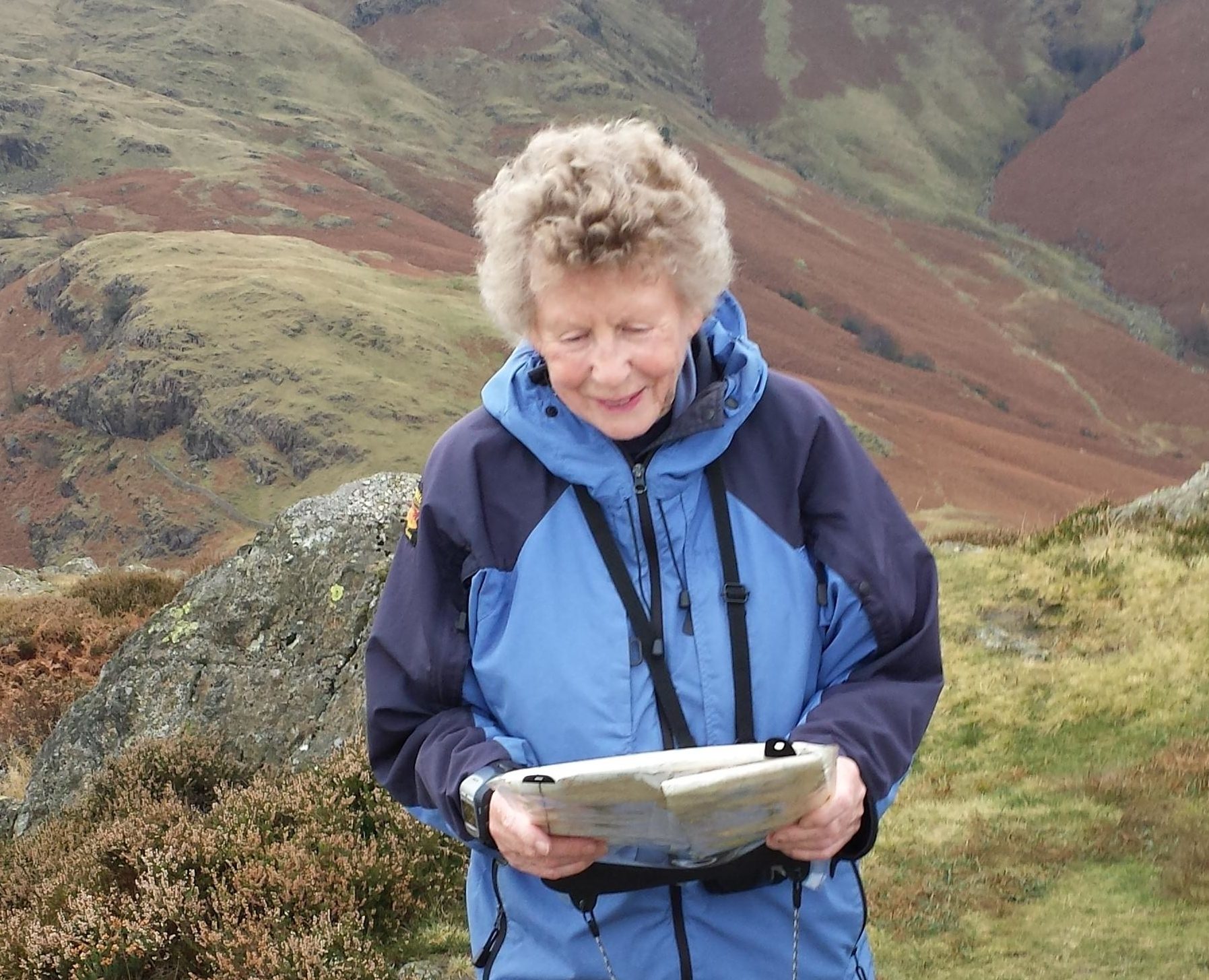
Leave a reply
Your email address will not be published.